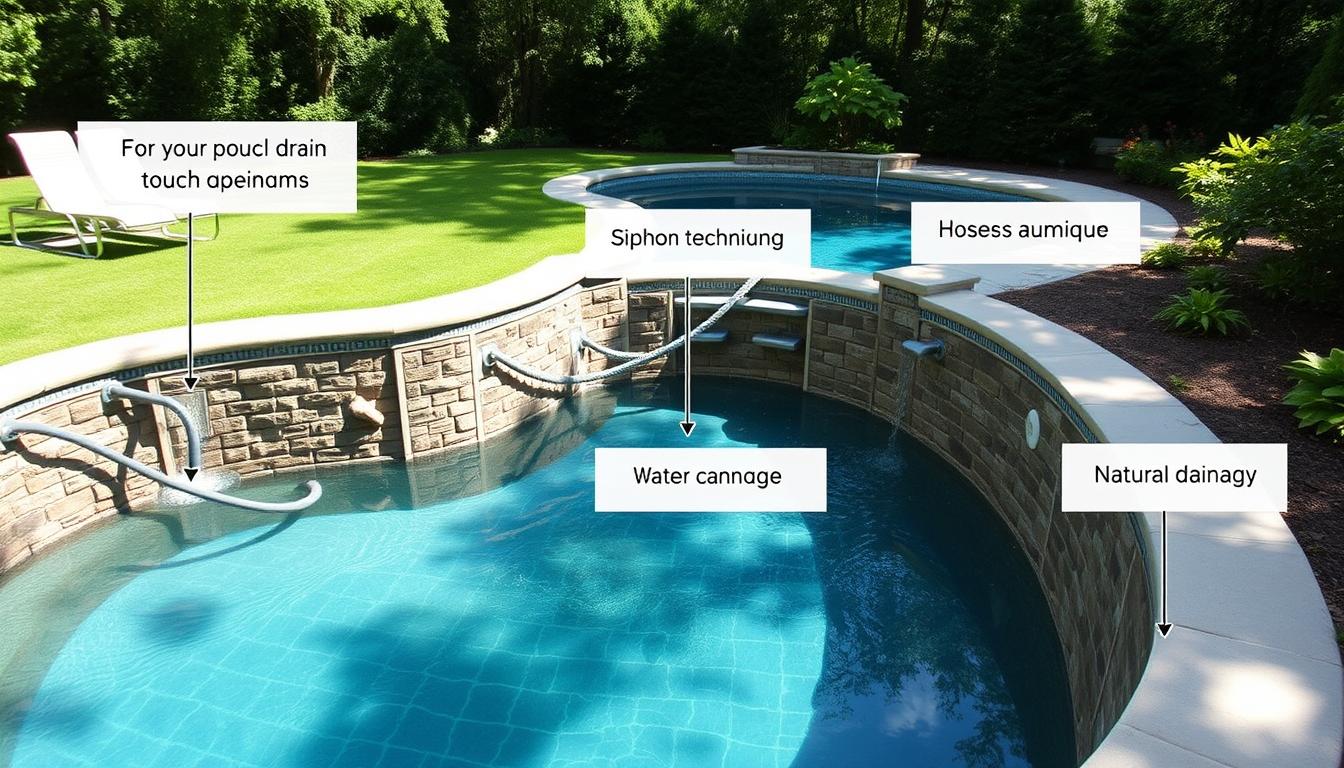
Pool maintenance is crucial for a clean swimming environment. Sometimes, draining an inground pool becomes necessary for repairs or chemical balancing. There are ways to empty a pool without using a pump.
You can drain a pool using a garden hose, gravity, or a submersible pump. It’s important to learn the proper methods and safety measures first. Consider local water disposal rules and potential pool damage.
Professionals should handle full pool draining for safety reasons. However, homeowners can partially drain pools to adjust chemicals or add fresh water. With the right knowledge, you can maintain your pool more hands-on.
Key Takeaways
- Inground pools can be drained without a pump using siphoning, gravity, or submersible pumps.
- Familiarize yourself with local regulations and potential risks before draining your pool.
- Partial draining for chemical adjustments or water refreshment can be done by homeowners.
- Proper techniques and safety precautions are crucial when draining an inground pool.
- Understand your pool’s volume and the time required for draining to plan accordingly.
Using a Garden Hose to Siphon Water
Siphoning is a cheap way to drain an inground pool without a pump. It uses a garden hose to create a vacuum effect. This DIY method helps pool owners save money and maintain their pools easily.
Priming the Hose for Effective Siphoning
Start by fully submerging the garden hose in the pool. Make sure both ends are underwater to keep air out. Move the hose hand-over-hand until you reach the other end.
When you see a small gush of water, seal that end with your palm. Keep it underwater. This step creates the vacuum effect needed for drainage.
Positioning the Hose for Optimal Drainage
Take the sealed end of the hose and place it downhill from the pool. Make sure the path is steep enough for water to flow freely. Keep a consistent slope to let gravity do its job.
Once the hose is in the right spot, release your palm. Let the water drain from the pool.
Monitoring the Siphoning Process
Watch the siphoning process closely. Look for kinks or blockages in the hose that might slow water flow. Check that the hose stays connected to the pool and drainage area.
This prevents accidental disconnection or flooding. Keep an eye on the water level as it drops.
| Pool Size | Hose Diameter | Estimated Drainage Time |
|---|---|---|
| Small (10,000 gallons) | 1 inch | 6-8 hours |
| Medium (20,000 gallons) | 1.5 inches | 8-10 hours |
| Large (30,000 gallons) | 2 inches | 10-12 hours |
These simple steps help pool owners drain inground pools using a garden hose. Siphoning is cost-effective and efficient for pool maintenance. It’s great for those who want to avoid expensive pumps or professional services.
How to Drain an Inground Pool Without a Pump
Draining an inground pool without a pump can be tricky. We’ll explore two effective methods: gravity draining and using a submersible pump. These techniques can help you empty your pool safely.
Gravity Draining Method
Gravity draining works when you don’t have a pump. First, lower the water level significantly. Then, remove the hydrostatic plugs on the pool floor.
This allows groundwater to enter and equalize pressure. It prevents damage to the pool shell. Watch the water level closely during this process.
Before draining your pool, check local regulations. Learn about discharge locations and water composition requirements from water authorities.
Utilizing a Submersible Pump
A submersible pump offers a faster way to drain your pool. Here’s how to use one effectively:
- Place the submersible pump at the lowest point of your pool.
- Connect a drainage hose to the pump and direct it to a safe disposal area.
- Turn on the pump and monitor the water level as it drains.
- Turn off the pump when the water level reaches it to prevent overheating.
Keep a close eye on the draining process. This helps avoid issues like the pump running dry or the hose coming loose.
| Method | Advantages | Disadvantages |
|---|---|---|
| Gravity Draining | No pump required, cost-effective | Slower process, requires close monitoring |
| Submersible Pump | Faster draining, more efficient | Requires access to a pump, potential for pump damage if not monitored properly |
Draining an inground pool comes with risks like pool pop-up or shell damage. Follow proper draining practices to minimize these risks. Address hydrostatic pressure concerns carefully.
If you’re unsure about the process, consider hiring a professional. They can safely handle complete drainage of your pool.
Conclusion
Draining an inground pool without a pump requires careful planning. Siphoning with a garden hose or using gravity can effectively remove water. However, it’s crucial to follow proper methods and local regulations for safe water disposal.
Homeowners can handle partial draining for maintenance. For complete drainage, consulting professionals is best to prevent costly damage. Inspect the pool before and after draining to ensure its integrity.
Understanding pool draining options helps maintain optimal condition. Careful planning and attention to detail are key. Following best practices ensures successful pool maintenance without expensive equipment.







